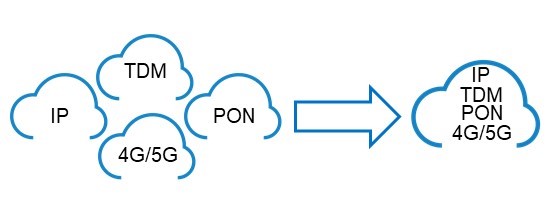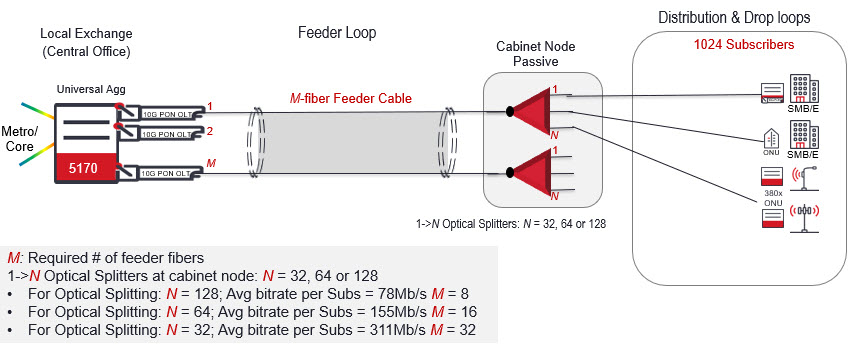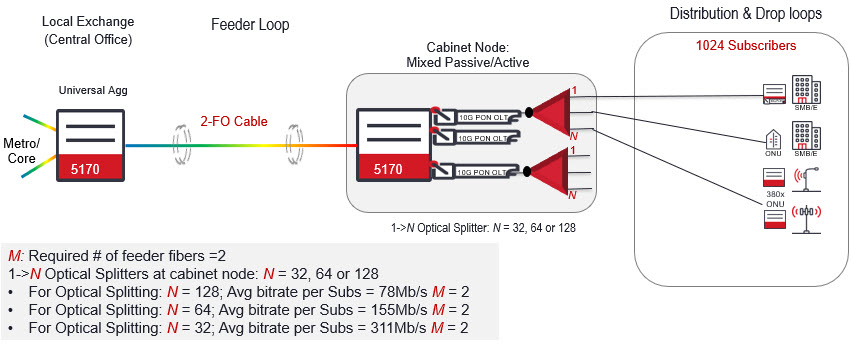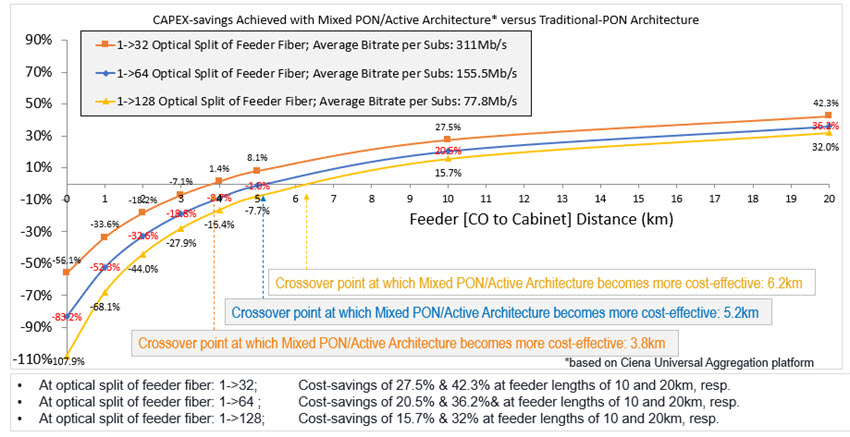Does universal aggregation hold the skeleton key for fiber utilization at the network edge?
Network operators spend billions every year on CAPEX, with a significant amount of that cost going to fibering the metro edge. Their goal is to provide an increasingly better user experience while keeping costs controlled to remain competitive.
In the past, network silos were built for multiple service types, including private line, business services, mobile, shared fiber, or Passive Optical Network (PON). Building standalone network architectures to support different types of services creates a costly, complex, and inefficient network footprint that increases both CAPEX and OPEX. Increasingly, operators are looking to universal aggregation solutions to solve their business challenges with the right speeds and feeds, and routing capabilities to support traffic for multiple service types.

Network Architecture Consolidation
Deploying fiber in the access loop to support services can be very challenging, as the access loop can vary depending where you live. In North America, access loop distances - between the central offices (COs) and the customers’ premises – can average ~ 7 miles compared to an average of 2 – 3 miles in Europe and Asia. Longer access fiber loops can be even more challenging for operators, as the asset value is not only worth more, but it also costs more. These costs, and more, can be reduced with Ciena’s universal aggregation solution, a purpose-built solution to address next-generation access, and low-cost metro access to allow for maximizing ROI.
Network operators can reduce PON FTTx deployment costs significantly by minimizing the cost of the long feeder loops via the deployment of mixed PON/Active Access architectures - based on the Ciena UA (Universal Aggregation) solution.
Making the case for low-cost high bandwidth
Services are demanding higher speed or connection rates, as consumers are streaming more video, playing more online games, and working from home. As a last mile technology, used between the subscriber and the network operator, PON applications are typically symmetrically limited to 1Gb/s for up to 32 customers or 32 Mb/s each. Deploying Ciena’s pluggable 10G/10G symmetrical XGS-PON solution (X=10, G=Gigabit, S=Symmetrical) – network operators can achieve both CAPEX-saving and PON reach extension, delivering 10x more bandwidth up to 4 times the number of customers (128) and enabling many higher-bandwidth applications. Universal aggregation is supported in a number of Ciena’s packet networking platforms, including the 5170 router.
In most typical PON deployments, an Optical Line Terminal (OLT) chassis is deployed in a central office or controlled environment, and then passively connected (using a feeder fiber cable) to Optical Network Units (ONU). This can be accomplished with Ciena’s 10G PON transceiver in the 5170 as shown below.

Central Office universal aggregation deployment
Ciena’s cost-effective single rack 5170 doesn’t restrict or limit OLT transceiver port placement, so thousands of customers can be supported. However, for use case consistency, 1024 customers are used. Each Ciena OLT transceiver can support up to 128 connections (connections can be multiple devices) using passive optical splitters (1:32, 1:64, 1:128).
As shown above the required number of feeder fibers (9, 16, 32) increase (cost) as bandwidth increases. Deploying 8 fibers can provide 128 each with 78Mb/s, 16 fibers can provide 64 customers 155 Mbps, and 32 fibers can provide 32 customers 311Mb/s.
To reduce fiber feeder costs even more network operators can deploy the 5170 to a remote environmentally controlled cabinet or use Ciena’s 5171 with coherent optics enabling extended temperatures and deployment hundreds of kilometers away.

Cabinet based universal aggregation deployment
As shown above the required number of feeder fibers (2) remains constant, freeing up valuable feeder fiber assets and pushing bandwidth to the network edge as the edge emerges as a critical location for connect, compute, and store.
Deploying 8 distribution and drop fibers can provide 128 each with 78Mb/s, 16 distribution & drop fibers can provide 64 customers 155 Mbps, and 32 distribution & drop fibers can provide 32 customers 311Mb/s.
Traditional PON versus PON/FTTx Architecture CAPEX-Savings
The table and figure below show the CAPEX – savings achieved – based on Ciena’s universal aggregation platform – at different optical split ratios of a feeder fiber as a function of the Feeder (CO to Cabinet) distance. This business model assumes brown field deployment scenario where network cost components include:
- CO/OLT node: electronics (Ciena 5170), SW & power
- Feeder Loop: cable material/installation and
- Cabinet node: optical splitters, electronics (Ciena 5170), power, Enclosure, CEV

Whether your fiber access loop is in North America (~7 miles) or Europe and Asia (~2-3 miles) Ciena’s universal aggregation solution can enable significant bandwidth increases and savings. With 2-4 times the number of customers and 10 times the bandwidth over traditional PON deployments.

Traditional PON vs. cabinet based universal aggregation CAPEX savings
Instead of building siloed, standalone architectures to support different types of services, operators can now bring more value to their networks by supporting concurrent PON, IP, and Ethernet services on the same Ciena aggregation platform.
Stay tuned, as I discuss OPEX-centric business case where the network operator feeder infrastructure is leased in the next part of this universal aggregation series for shared fiber for 10G PON. To find out how to unlock your metro access fiber assets ask us how Ciena helps Evolutionize Your Packet Network.
What’s in your Network Edge?






